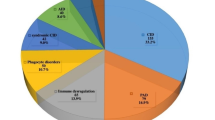Abstract
The objective of this study was to assess the validity of using the Kobayashi, Sano and Egami scoring systems to predict the intravenous immunoglobulin (IVIG) resistance of Kawasaki disease (KD) and to identify the predictors of IVIG resistance in our Thai population. A retrospective study involving 130 KD patients who were admitted between January 2005 and April 2018 was performed. We found that 17 (13%) KD patients did not respond to the first IVIG dose. The three scoring systems have good specificity (80.8%, 74% and 92.1%, respectively) but low sensitivity (0%, 33.3% and 22.2%, respectively). Multivariate analysis suggested that a body temperature greater than 40.2 °C (odds ratio of 3.80, P value = 0.03), a neutrophil percentage greater than 74% (odds ratio of 3.82, P value = 0.03) and serum albumin less than 3 g/L (odds ratio of 5.09, P value = 0.01) were predictors of IVIG resistance. Our study cannot conclude that the three Japanese scoring systems are not suitable for predicting IVIG resistance in the Thai population due to study limitations. However, a high-grade fever (≥ 40.2 °C), neutrophil predominance ≥ 74% and hypoalbuminemia (serum albumin level < 3 g/L) were predictors of IVIG resistance in Thai KD patients.
Similar content being viewed by others
References
McCrindle BW, Rowley AH, Newburger JW, Burns JC, Bolger AF, Gewitz M et al (2017) Diagnosis, treatment, and long-term management of Kawasaki disease: a scientific statement for health professionals from the American Heart Association. Circulation 135(17):e927–e999
Newburger JW, Sleeper LA, McCrindle BW, Minich LL, Gersony W, Vetter VL et al (2007) Randomized trial of pulsed corticosteroid therapy for primary treatment of Kawasaki disease. N Engl J Med 356(7):663–675
Chen S, Dong Y, Kiuchi MG, Wang J, Li R, Ling Z et al (2016) Coronary artery complication in Kawasaki disease and the importance of early intervention : a systematic review and meta-analysis. JAMA Pediatr 170(12):1156–1163
Kobayashi T, Saji T, Otani T, Takeuchi K, Nakamura T, Arakawa H et al (2012) Efficacy of immunoglobulin plus prednisolone for prevention of coronary artery abnormalities in severe Kawasaki disease (RAISE study): a randomised, open-label, blinded-endpoints trial. Lancet (London, England) 379(9826):1613–1620
Kobayashi T, Inoue Y, Takeuchi K, Okada Y, Tamura K, Tomomasa T et al (2006) Prediction of intravenous immunoglobulin unresponsiveness in patients with Kawasaki disease. Circulation 113(22):2606–2612
Seki M, Kobayashi T, Kobayashi T, Morikawa A, Otani T, Takeuchi K et al (2011) External validation of a risk score to predict intravenous immunoglobulin resistance in patients with Kawasaki disease. Pediatr Infect Dis J 30(2):145–147
Sano T, Kurotobi S, Matsuzaki K, Yamamoto T, Maki I, Miki K et al (2007) Prediction of non-responsiveness to standard high-dose gamma-globulin therapy in patients with acute Kawasaki disease before starting initial treatment. Eur J Pediatr 166(2):131–137
Egami K, Muta H, Ishii M, Suda K, Sugahara Y, Iemura M et al (2006) Prediction of resistance to intravenous immunoglobulin treatment in patients with Kawasaki disease. J Pediatr 149(2):237–240
Tremoulet AH, Best BM, Song S, Wang S, Corinaldesi E, Eichenfield JR et al (2008) Resistance to intravenous immunoglobulin in children with Kawasaki disease. J Pediatr 153(1):117–21.e3
Sleeper LA, Minich LL, McCrindle BM, Li JS, Mason W, Colan SD et al (2011) Evaluation of Kawasaki disease risk-scoring systems for intravenous immunoglobulin resistance. J Pediatr 158(5):831–5.e3
Davies S, Sutton N, Blackstock S, Gormley S, Hoggart CJ, Levin M et al (2015) Predicting IVIG resistance in UK Kawasaki disease. Arch Dis Child 100(4):366–368
Arane K, Mendelsohn K, Mimouni M, Mimouni F, Koren Y, Brik Simon D et al (2018) Japanese scoring systems to predict resistance to intravenous immunoglobulin in Kawasaki disease were unreliable for Caucasian Israeli children. Acta paediatr 107(12):2179–2184
Chantasiriwan N, Silvilairat S, Makonkawkeyoon K, Pongprot Y, Sittiwangkul R (2018) Predictors of intravenous immunoglobulin resistance and coronary artery aneurysm in patients with Kawasaki disease. Paediatr Int Child Health. https://doi.org/10.1080/20469047.2018.1471381
Shin J, Lee H, Eun L (2017) Verification of current risk scores for Kawasaki disease in Korean children. J Korean Med Sci 32(12):1991–1996
Fu PP, Du ZD, Pan YS (2013) Novel predictors of intravenous immunoglobulin resistance in Chinese children with Kawasaki disease. Pediatr Infect Dis J 32(8):e319–e323
Qian W, Tang Y, Yan W, Sun L, Lv H (2018) A comparison of efficacy of six prediction models for intravenous immunoglobulin resistance in Kawasaki disease. Ital J Pediatr 44(1):33
Dallaire F, Dahdah N (2011) New equations and a critical appraisal of coronary artery Z scores in healthy children. J Am Soc Echocardiogr 24(1):60–74
Dimitriades VR, Brown AG, Gedalia A (2014) Kawasaki disease: pathophysiology, clinical manifestations, and management. Curr Rheumatol Rep 16(6):423
Kuo HC, Liang CD, Wang CL, Yu HR, Hwang KP, Yang KD (2010) Serum albumin level predicts initial intravenous immunoglobulin treatment failure in Kawasaki disease. Acta paediatr 99(10):1578–1583
Baek JY, Song MS (2016) Meta-analysis of factors predicting resistance to intravenous immunoglobulin treatment in patients with Kawasaki disease. Korean J Pediatr 59(2):80–90
Burns JC, Franco A (2015) The immunomodulatory effects of intravenous immunoglobulin therapy in Kawasaki disease. Expert Rev Clin Immunol 11(7):819–825
Okada Y, Shinohara M, Kobayashi T, Tomomasa T, Kobayashi T, Morikawa A (2003) Effect of corticosteroids in addition to intravenous gamma globulin therapy on serum cytokine levels in the acute phase of Kawasaki disease in children. J Pediatr 143:363–367
Funding
No disclosure.
Author information
Authors and Affiliations
Corresponding author
Ethics declarations
Conflict of interest
The authors hereby declare no personal or professional conflicts of the interest with any aspect of this study.
Additional information
Publisher's Note
Springer Nature remains neutral with regard to jurisdictional claims in published maps and institutional affiliations.
Rights and permissions
About this article
Cite this article
Jarutach, J., Roymanee, S. & Wongwaitaweewong, K. Verification of “Japanese Scoring Systems” to Predict IVIG Resistance and Identification of Predictors for IVIG Resistance in Thai Children with Kawasaki Disease. Pediatr Cardiol 42, 1799–1804 (2021). https://doi.org/10.1007/s00246-021-02668-0
Received:
Accepted:
Published:
Issue Date:
DOI: https://doi.org/10.1007/s00246-021-02668-0




